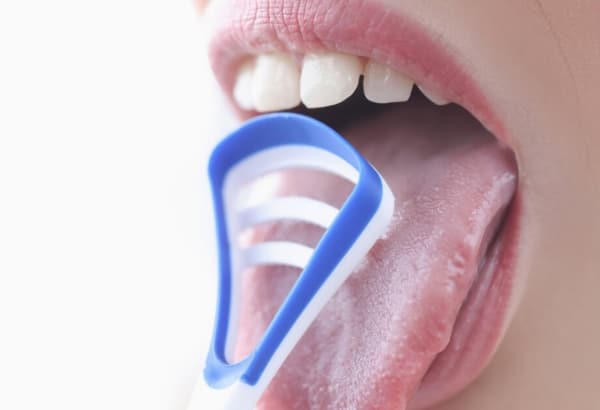Your Tongue:
For such a seemingly small part of your body, the tongue actually plays a major role in many everyday functions, such as talking, helping you digest and taste food, and swallowing. In fact, the appearance of your tongue may speak volumes about the state of your oral and overall health.
Did you know your mouth is home to more than six million bacteria of 700 different types. In fact, of all the body parts, the mouth has the most bacteria. The environment of the mouth is ideal for unicellular microorganisms. Most of the bacteria in the mouth are found on the tongue.
The structure and texture of the tongue are the reasons why bacteria quickly accumulate on it. Two-thirds of the tongue’s front surface is covered with papillae, which gives the tongue its rough, carpet-like appearance. Additionally, the tongue has many crevices, nooks, and crannies that make perfect hiding spots for bacteria.
Bacteria, food particles, and dead cells that lodge between the papillae form a white coating when the tongue is neglected. This condition is called white tongue. While white tongue is often not a symptom of a severe health condition, it does impact a person’s oral and overall health.
How to get rid of white tongue
In most cases, white tongue is easy to resolve as the condition is usually related to oral hygiene and lifestyle. Here are some ways to treat and prevent white tongue.
- Practice regular and proper brushing and flossing.
- Avoid excessive alcohol use.
- Drink plenty of water to avoid dry mouth.
- Stop smoking or chewing tobacco.
- Scrape off the white coating with a tongue cleaner.
.

Benefits of Scraping Your Tongue:
- Tongue cleaning fights periodontal disease.
- Tongue cleaning improves taste.
- Reduce halitosis (bad breath).
- Tongue cleaning boosts immunity and digestion.
Haven’t Heard of Tongue Scraping?
Tongue cleaning is not a new idea it has existed in Ayurvedic practice since ancient times and has been practiced for centuries in, Africa, Arabia, Europe, South America and many Eastern and Oriental cultures. Only recently has this oral hygiene practice become more popular in the west.
Originally tongue scrapers were made from materials such as flexible wood sections, metals, ivory, mother-of-pearl, whalebone, celluloid and tortoiseshell,
Today, tongue scrapers are more commonly made from:
- Stainless steel
- Copper or
- Plastic.
Benefits of Scraping Your Tongue:
Tongue cleaning fights periodontal disease. If you leave bacteria on your tongue to grow and thrive, it can increase your risk of developing tooth decay and gum disease.

Tongue cleaning improves taste. By regularly removing the bacterial build-up (coating) off your tongue, your tongue may be able to better distinguish between bitter, sweet, salty, and sour sensations.
Reduce halitosis (bad breath). Although tongue scraping can’t replace brushing your teeth, removing bacteria and plaque from your tongue can help to temporarily get rid of bad breath. However, please note that you must use your tongue scraper regularly for this to last.
Tongue cleaning boosts immunity and digestion. Your tongue is an important component of your immune system and keeping it clean helps to prevent toxic buildup from being absorbed into your body. Several studies suggest there may be a link between periodontal/gum disease and the progression of other systemic diseases such as diabetes, heart disease, respiratory disease, cancer and Alzheimer’s
Tongue scraping is meant to be used in tandem with brushing and flossing— not as a replacement. But, it’s a fast way to remove extra, unhelpful particles from your tongue’s surface.
How to Use Your Tongue Scraper:
- Open your mouth wide and stick out your tongue. It helps to stand in front of a mirror when cleaning your tongue because you can see the inside of your mouth better.
- Put the tongue cleaner in your mouth as far back as you can. Do this carefully. Some people gag when using a tongue cleaner. If this happens to you, adjust the pressure and position the tongue cleaner accordingly.
- Gently scrape your tongue starting from the back to the front to eliminate white coat formation and debris. Do this multiple times at different angles until you have covered the entire top surface of your tongue.
- Spit out excess saliva or rinse your mouth with water to eliminate the remaining white coating and food particles.
- Rinse the tongue scraper with warm water or wipe it off with a clean damp cloth to remove the debris.
- Repeat the process many times until you feel that your tongue is clean. In most cases, twice is enough.
- Once done, wash the tongue cleaner with warm water and soap before storing it.
If you have any questions about tongue scraping or how to improve your oral health, we’d love to help. Give us a call at 604-854-6162.
The content of this blog is not intended to be a substitute for professional medical advice, diagnosis, or treatment. Always seek the advice of qualified health providers with questions you may have regarding medical conditions.


